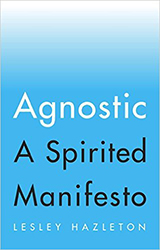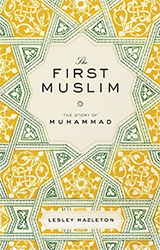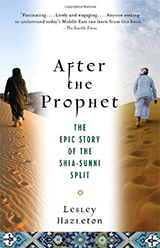I love the fact that yesterday, the day he won the Nobel Prize in physics, Peter Higgs couldn’t be found. He was off “somewhere in Scotland” with no cell phone, no email, no address. That, I think, is winning in style.
Higgs is the father, as it were, of the Higgs boson, aka “the God particle.” As you might suspect, it wasn’t him who gave it so grandiose and eye-catching a nickname. That was a colleague in search of a selling book title, who later said that what he really wanted to call it was “the goddamn particle.”
Not being a physicist, I’ve had trouble figuring out exactly what this boson is — in fact, what any boson is. (Not that physicists have had it any easier: it took ten thousand of them 53 years to follow up on Higgs’ first theoretical paper until they proved the boson’s existence just last year — after sifting 2,000 trillion subatomic fireballs through CERN’s Large Hadron Collider. Yes, two thousand trillion — that’s why it’s large.)
But then lo and behold, this morning: epiphany! Denis Overbye at the NYT described the Higgs boson in terms I can almost grasp, along with a short video he begins this way: “The Higgs boson is not for the faint of heart. It’s tough stuff, even for physicists.”
Gulp. But gird up your loins, because this is worth it. It brims with enticing ideas to play with — a grand portal to the intersection of physics and metaphysics.
The Higgs was the last missing ingredient of the Standard Model, a suite of equations that has ruled particle physics for the last half-century, explaining everything from the smell of a rose to the ping when your computer boots up.
According to this model, the universe brims with energy that acts like a cosmic molasses, imbuing the particles that move through it with mass, the way a bill moving through Congress attracts riders and amendments, becoming more and more ponderous and controversial.
Cosmic molasses. Am into that.
Without the Higgs field, many elementary particles, like electrons, would be massless and would zip around at the speed of light. There would be no atoms and no us.
For scientists, the discovery of the Higgs (as physicists call it) affirmed the view of a cosmos ruled by laws of almost diamond-like elegance and simplicity, but in which everything interesting — like us — is a result of lapses or flaws in that elegance.
You can see why I love this. It’s an intensely esthetic idea — an intensely existential, philosophical and psychological one too — in which flaws and imperfections are exactly what makes life interesting. There’s a touch of kabbala in it (real kabbala, not Madonna red-string theory). A good dose of Spinoza, perhaps. And a marvelous challenge to the naive and pernicious idea of human perfectibility.
At the heart of the physicists’ quest, Overby continues, was
an ancient idea, the concept of symmetry, and how it was present in the foundations of physics but hidden in the world as we experience it. In art and nature, something is symmetrical if it looks the same when you move it one way or another, like a snowflake rotated 60 degrees; in science and math, a symmetry is something that does not change when you transform the system, like the length of an arrow when you turn it around or shoot it.
All fundamental forces were the result of nature’s trying to maintain symmetries, physicists realized — for example, the conservation of electric charge in the case of electromagnetism, or the conservation of momentum and energy in the case of Einstein’s gravity. But…
By a process called symmetry breaking, a situation that started out balanced can wind up unbalanced. Imagine, for example, a pencil standing on its tip; it will eventually fall over and point only one way out of many possibilities. The mass of the boson can be thought of as the energy released when the pencil falls.
“The energy released when a pencil falls.” There’s poetry here, and I’ve only sampled it, so read the whole article (it’s misleadingly headlined — hello, NYT editors? — so scroll down to paragraph 10 and read on from there), and let the imagination soar…






Lesley, if you have not read “The God Particle” by Leon Lederman, I highly recommend it. Not only is it quite understandable (Lederman is an experimental physicist, rather than theoretical), it is very funny in places, so quite an entertaining read as well.
I haven’t, but now see that he’s just published a new book called — appropriately? — “Beyond the God Particle.” The meta-God particle?
Now, how can this be turned into a weapon? Just kidding I’m sure no-one would do that…
There is an even simpler way of understanding the God particle. It is what gives everything the mass that they need to exist, meaning that it surrounds everything and touches everything yet is itself elusive. That is the definition of God as we understand from the Quran,
He is everywhere and touches everything, yet Himself is Elusive.
Yes Bushra, you are on the track. Although difficult to propound on the issue being a non physicist but still will throw in my bits. The mention of ‘God’ here may not go well with agnostics but it is necessary here. The Qur’an 1400 years ago says that God created the Heavens and the Earth (plain to see) and ‘everythings between them’ (Invisible), when there was nothing before except a little smoke like substance. (Qur’an was also the first to point out that Earth is not flat as earlier supposed, but round like the ‘egg of an Ostrich’ and spinning on its axis and going around the Sun, many centuries before the Europeans. It contains many scientific facts proven right by science only today.) The greatest scientist the world has ever known -Albert Einstien said, ‘Religion is blind without science and science is lame without religion’.
However, these ‘God particle’ or ‘Higgs boson’ originates from an invisible field that fills up all space even when the Universe seems empty and dark, this field is there as these particles are everywhere yet bafflingly elusive or so it remained until the discovery. (First propounded by a sage-scientist -Dr Abdus Salam of Pakistan that won him the Noble Prize and the Einstein Medal in 1979). Fundamental particles travel through this field and some interact yet some don’t. Without it, we and all other joined up atoms in the Universe would not exist, says theorists. This makes a lot of sense as it also serve as a medium of contact because it is from this contact that particle acquire mass by the Will of God He says Be! And it becomes!
At the risk of seeing this devolve into a religious discussion, I recognize that many world views incorporate the concept of an Ultimate Architect, if you will. The Einstein quote is right on. In my estimation, the most successful religions – and by “successful” I mean philosophically, not in terms of numbers of followers – evolve as the knowledge of the universe around us evolves. Although I am not a religious man, I do not hold to the notion that science and the concept of God are necessarily incompatible. Many scientists see their research as not only a means to understanding the Universe, but also as a means to understanding the mind of God. The transcendent nature of God as described by Spinoza, Lin Yutang and, apparently, in the Q’uran as well suggests that, as we refine our understanding of the Universe, we come closer to that goal.
[Hmmmm….. if we find that ours is just one universe in an infinite soup of multiverses, will western religions still subscribe to the one god concept? No way to prove or disprove, of course, but perhaps we live in a one god per universe multiverse!]
When Europe was muddling through the Dark Ages, the Islamic world was laying the foundation for the language of physics: modern mathematics. It is sad to contemplate such a rich tradition rejecting its own heritage, which appears to be inevitable if fundamentalists take control. I fear the same outcome in the U.S. if the Conservative Christian Right is allowed to co-opt governmental policy. Religious texts which were drafted thousands of years ago require reinterpretation by enlightened minds, as we [hopefully] continue to evolve. What good is new knowledge of the world around us and changing conditions if we neglect to incorporate them into our policies? What good is civil discourse if, in the end, the presumption is that nothing can change because of a bunch of laws written by individuals of another place and time who, necessarily, possessed a far less comprehensive view of the world than an educated 21st century individual does?
Well, let’s call it a philosophical discussion rather than a religious one. Isn’t the crux of religion — beyond the primitive and false dichotomy of believe-or-don’t-believe — philosophical? In fact it seems to me that much of philosophy, up to today, has revolved around sheer amazement A. that we exist, and B. that we can think. Or at least, as you point out, that some of us can think. The Dark Ages is indeed where the Banana Republicans would dearly love to take us all.
Agreed on all points.
wow, i am impressed, as someone with a non-scientific brain!